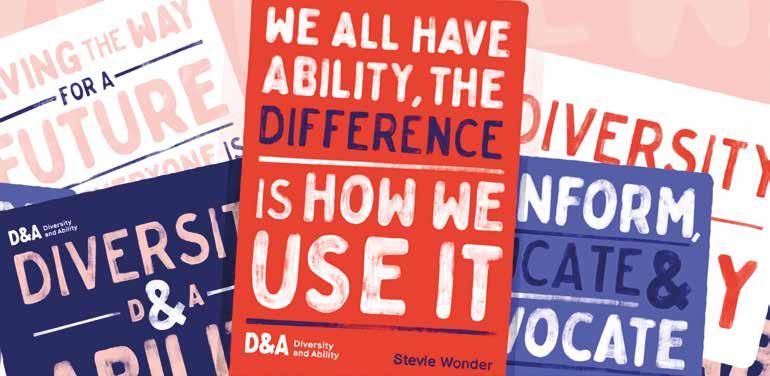
12 minute read
UK Disability History Month
NOVEMBER is UK Disability History Month (UKDHM), so we’re shining a spotlight on some issues surrounding disabled members and students during the pandemic.
PHOTO by Kois Miah
These were Stevie Wonder’s words at the 2016 Grammy music awards when he joked that he was the only person in the hall able to read the name of the Song of the Year winner, written in Braille on the golden envelope.
But for the 11th UK Disability History Month, starting in November, the question of access remains a serious issue.
Participation on an equal level
Disabled people have a fundamental human right to gain access and participation on an equal level with others, regardless of our impairments. However, for many years disabled people struggled to adapt to society’s lived physical and information environment.
The first International Human Rights Treaty to explicitly include accessibility as a principle was the UN Convention on the Rights of Persons with Disabilities in 2008. There had been national laws, building codes and standards partially acknowledging the need for access in the previous 120 years.
All of these were fought for by disabled people, their organisations and some nondisabled-led charities. People with sensory impairments were in the vanguard, arguing for the teaching and use of Braille and sign language, gaining concessions in a minority First, UKDHM founder Richard Rieser (pictured left at a UN Stand Up to Racism march) introduces this year’s theme – access – with some historical background.
On pages 23 and 24, we talk to NEU executive officers Colleen Johnson, Louise Regan and Nicky Downes about the union’s guidance for disabled members and the current challenges for at-risk members during the coronavirus crisis.
While on page 25, special needs teacher and dyslexia specialist Jane Parker suggests a multisensory approach to create dyslexiafriendly learning environments.
Our Final word on page 50 is written by Diversity and Ability’s chief executive Atif Choudhury, who outlines a social model approach to understanding educational barriers; and read about the International Day
of People with Disabilities on page 37.
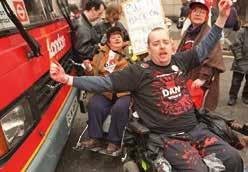
Protests by members of the Direct Action Network in 1995 led to London buses becoming accessible of mainly higher income countries. More recently, people with learning difficulties have fought for access to ordinary education.
Members of Direct Action Network (DAN) chained themselves to buses in 1995, which led to more accessible transport in London – visit bit.ly/3lg1Smq
Breaking down barriers
Disabled people were seen as a problem to be made normal, a ‘medical model’ approach. Now the barriers faced by disabled people with a multitude of impairments need resolving. This is the ‘social model human rights’ approach.
Accessibility is at the core and ICT has become much better at incorporating access and principles of universal design.
In all subjects and at all levels, pupils can study the struggles, the barriers and the solutions. They can map their school or local area and its public transport, to identify barriers. They can work with teachers
Feature
Self-ID is first step to asking for appropriate adjustments
WITH the threat of coronavirus hanging over them, teachers and “We believe initially, but they can start by self-identifying to us, their union. Hopefully soon they’ll feel support staff are being urged to push for every possible measure barriers, attitudes more confident to identify to their employer and then ask for the appropriate adjustments to help ensure their health, safety and wellbeing. and inflexibility at work.” The NEU believes that, while it is important in society hold Regular online meetings during Covid During the Covid pandemic Colleen, along to keep schools open wherever possible for the sake of pupils’ education and mental health, us back.” with national executive member Nicky Downes and Louise Regan, ex-president educators must also put their own health at and officer for membership and equality, has the forefront of their priorities. Colleen Johnson been hosting regular online meetings to give
The union prefers to use the phrase ‘at members the chance to air their concerns, ask increased risk’ rather than the Government’s questions and seek advice. labels of clinically vulnerable and clinically due to long-term medical health conditions Called national informal drop-in extremely vulnerable (CV and CEV), but self-identify as disabled members so that they meetings for disabled/at-risk members, either way, there are many school staff who fall benefit from being part of a strong, organised she says they are held to reinforce the into these categories. equality group within the union. NEU’s advice in a way that “In the NEU we believe in the social can be used in real-life Self-identity with your union Colleen Johnson, national executive seat holder for disabled members, says it is crucial that people who feel they are at increased risk model of disability. This means that barriers, attitudes and inflexibility in society hold us back,” she adds. “Many people do not feel confident enough to inform their employer situations. continued on pages 24 & 25 Self-identify with the union: visit myneu.org.
uk and click on ‘Accessible to every sin gle disabled person’ the equality bar
Much modern ICT, such as this Braille computer, has incorporated accessibility into its design
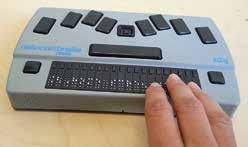
on lesson objectives and plans to find what needs to change so all have access and can benefit.
Shops, offices, workshops and factories can be visited online or in person to identify barriers and solutions. Pupils can then start local campaigns to rectify injustices they find.
Resources for pupils of all age groups
Access is the theme of this year’s UK Disability History Month when organisers ask: How far have we come? How far have we got to go?
It launches online on the evening of Wednesday, 18 November, running until Friday, 18 December.
Activities include developing and sharing a wide range of resources to: n understand the importance of the struggles of disabled people for access n understand the human rights principle of access for disabled people n apply universal design to environmental, communication, educational, occupational and organisational issues to minimise barriers to disabled people and maximise our participation.
There are many assembly, lesson and project ideas for different age groups as well as background and events information on the UK Disability History Month website at ukdhm.org Richard Rieser, general secretary of the Commonwealth Disabled People’s Forum
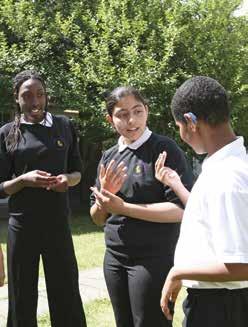
Pupils at Lister Community School in Newham, east London, chat in sign language. The school is the resourced provider for secondary aged deaf and partially hearing students in the borough
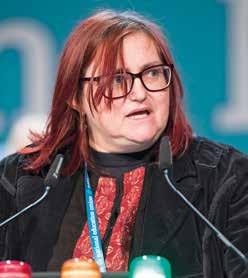
Nicky Downes
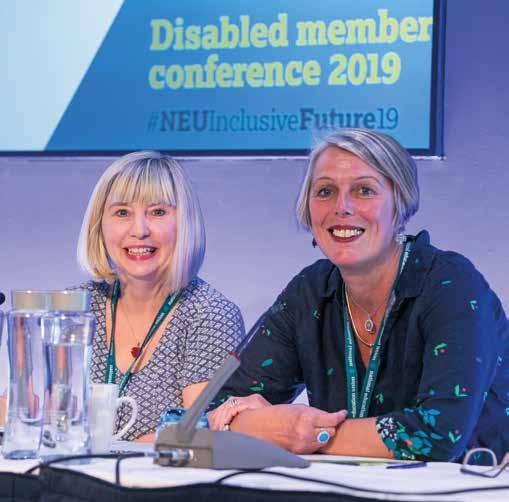
(Above left) Nicky Downes. (Above) Colleen Johnson and Louise Regan
PHOTOS by Kois Miah
continued from page 23
Health issues raised in online meetings in relation to Covid-19 have included older age and high blood pressure, as well as specific health conditions such as brittle asthma, rheumatoid arthritis and cystic fibrosis.
The union stresses the importance of members getting individualised risk assessments that are regularly updated, something that is particularly important in areas where there is a high incidence of the disease.
Louise Regan told a recent meeting: “There are CV members who want to be back at work. We need all these members to have good risk assessments that are updated regularly.”
Referral to their relevant occupational health team is also regarded as an important part of keeping members safe.
Using the Government’s terminology, the union believes that anyone who is CEV should be working from home, without question, while those who are CV can be in school but working with ‘mitigating measures’ such as masks and two-metre social distancing.
Another of the drop-in Zoom meetings discussed ‘collectivisation’ and the importance of being active by regularly attending district and branch general meetings to raise issues relating to at-risk members.
Nicky Downes, who is also district secretary for Coventry, told the meeting: “We should collectivise in schools on this issue [of Covid], across the whole school and with other unions as well. If you are in a school group and you feel there are those at risk, we can escalate that.”
‘These are people’s lives; it isn’t a game’
Louise added: “Any concerns should be escalated through districts and branches, to regions and even to us if necessary. We have to make sure we stay strong as union groups and keep supporting each other. Don’t feel that you haven’t got backing – that’s why we’re here.
“These are people’s lives, this isn’t a game and we have to take it very seriously.”
She, Nicky and Colleen discuss any issues raised with them so they can offer the best advice to members. One recent topic concerned at-risk educators being told to wear different coloured lanyards from other staff, something they agreed was totally inappropriate.
In the first instance, contact your branch or district secretary to raise any of the issues in this article.
The union website also has a host of advice for at-risk members, including those who are pregnant.
“Basically, what we are striving for is to keep people as safe as possible,” Colleen says.
“A lot of our at-risk members wanted to get back to work but it’s a very mixed picture, it’s a balancing act.”
We’re here to help
n neu.org.uk/coronavirus-at-risk n neu.org.uk/coronavirus-
pregnancy-maternity-and-childcare
n myneu.org.uk
Jane Parker has been a class teacher, SEN co-ordinator and a dyslexia specialist teacher for a number of years. Here she describes how multisensory teaching could help with the challenges that lie ahead.
LOCKDOWN has been a frustrating time for pupils, parents and teachers, leaving many on the brink of an educational crisis.
Educational experiences during lockdown have varied in amount, structure and quality. The challenge now will be to support all pupils in returning to effective learning, especially those who have special educational needs (SEN) and specific learning needs.
In 2019, prior to coronavirus, the British Dyslexia Association noted that there appeared to be little in the way of specialist teaching interventions available in schools due to a lack of resources and tight budgets.
It also noted that the absence of early identification and adequate intervention in schools was causing a correlating rise in the
LONG Covid, the protection of pregnant women and the need for school nurses were among topics raised at the 23 September national informal drop-in meeting for disabled/at-risk members.
The online meetings give people the chance to air their concerns, share experiences and seek advice from the panel members and others taking part.
There was a general consensus that some head teachers were being wrongly advised that pregnant staff could be in school after 28 weeks, and that teaching assistants should not be sitting with sick children who were waiting to go home while showing possible Covid symptoms.
Several callers described how they would prefer to be working from home because of health issues but they either did not know how to raise it with their heads or they had been refused permission.
Sarah, a 65-year-old asthmatic with an older, at-risk husband, said as there had been number of pupils who have mental health issues and behavioural difficulties. As pupils start to return to school, it is more important than ever to get specialist teaching interventions.
What are the markers of dyslexia?
Markers of dyslexia, for the purpose of early identification and individualised intervention, include difficulties with phonological awareness, problems with memory, low selfesteem and co-occurring difficulties.
Pupils who have a specific learning difficulty such as dyslexia often have other co-occurring difficulties. They may have difficulty with maintaining attention, motor co-ordination or dysgraphia (writing skills). They therefore require multisensory ‘hands on’ physical activities, sufficient breaks and lots of praise, especially during writing activities.
This will be challenging for schools because use of physical resources is limited under Government guidance. Many special
“… School nurses to help diagnose the virus and take the pressure off educators.” Harry
two positive cases of coronavirus in her school, she would like the option to work from home and asked how she should go about it.
Peter asked if the union was pushing for the reinstatement of shielding and stringent social distancing as the number of cases continued to rise. “In my school there has been a dominant group-think of ‘let’s just get on with this’,” he said, with many staff not wearing PPE in communal areas.
Could the union suggest having health schools are leading the way on innovative use of musical instruments, plastic bricks and other sensory resources.
Research shows multisensory interventions are extremely valuable as they enable pupils to learn through as many senses as possible, helping to develop neural pathways within the brain.
The value of multisensory approaches has been reinforced through studies over many years. Montessori schools have been employing a multisensory strategy for more than a hundred years. The key is flexibility, while using a child’s preferred learning style to build on their strengths so they can learn more quickly. Pupils with dyslexia, for example, may display strengths in problem solving and design, creative, interactive and oral skills.
An obvious long-term answer lies in training more specialist teachers to provide support for learners and carry out diagnostic
Join our drop-in online meetings and have your say
assessments within schools. professionals such as nurses in schools to help diagnose the virus and take the pressure off educators who were not medically trained, Harry asked?
Marcela, who is 22 weeks pregnant, was concerned about staff absences, due to illness and self-isolation, causing several cover staff to be called in. “Where do I stand? I don’t feel like I’m in a secure safe place any more,” she said.
Kate said she took more than four months to recover from the virus, suffering from severe fatigue, constant muscle ache and a kind of ‘brain fog’. “There is a recognised condition of long-haul Covid now. We’re going to have even more long-term disabled members,” she said.
To join one of the drop-in meetings, check with your school rep, a member of the disabled members’ organising forum or visit the Disabled Network Facebook page.




